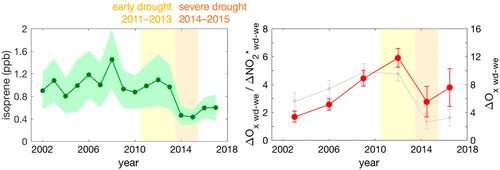How severe drought influences ozone pollution

From 2011 to 2015, California experienced its worst drought on record, with a parching combination of high temperatures and low precipitation. Drought conditions can have complicated effects on ozone air quality, so to better understand the process, researchers have analyzed data from two ozone-polluted cities before, during and after the California drought. They report their results in ACS' journal Environmental Science & Technology.
Although ozone in the stratosphere protects the earth from ultraviolet radiation, at ground level the molecule is a harmful air pollutant to humans, animals and plants. Ground-level ozone forms when nitrogen oxide compounds, primarily from motor vehicle emissions, react with volatile organic compounds (VOCs) from natural and anthropomorphic sources. Isoprene, a VOC emitted by plants, is a significant contributor to ozone production during summer months in many locations around the world. However, plants also decrease air ozone levels by taking the gas up through pores in their leaves. Because drought conditions affect both of these plant-related processes, Angelique Demetillo, Sally Pusede and colleagues wanted to examine air concentrations of isoprene and ozone—as well as leaf area index, nitrogen dioxide and meteorology—before, during and after the California drought.
For their study, the researchers analyzed publicly available data collected from the ground and satellites in Fresno, an ozone-polluted city close to an oak savanna, and Bakersfield, California. They found that isoprene concentrations did not change significantly during the early drought, but they dropped by more than 50 percent during the most severe drought conditions. The effects of drought on isoprene were also dependent on atmospheric temperature.
The researchers found that drought altered ozone production such that the process became chemically more sensitive to the decrease in isoprene and other drought-affected VOCs. These factors led to an estimated overall decrease in ozone production of approximately 20 percent during the severe drought. However, this decrease was offset by a comparable reduction in ozone uptake by plants, leading to only a 6 percent reduction in ozone levels overall during the severe drought period.
These results suggest that drought influences on ozone pollution are complex and depend on drought severity and duration, the researchers say.
More information: Mary Angelique G. Demetillo et al. Observing Severe Drought Influences on Ozone Air Pollution in California, Environmental Science & Technology (2019). DOI: 10.1021/acs.est.8b04852
Journal information: Environmental Science & Technology
Provided by American Chemical Society



















